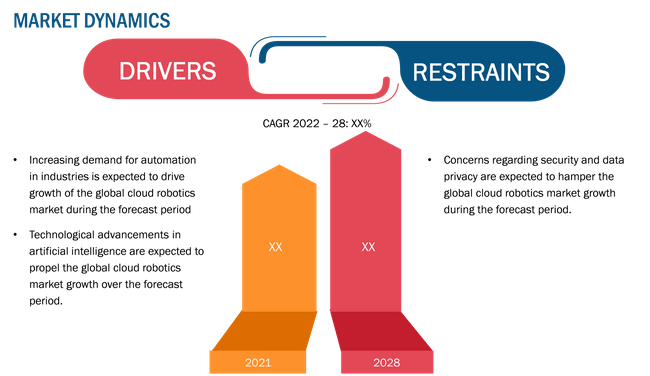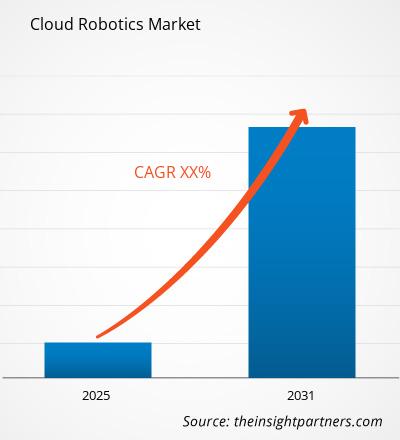نظرة عامة على السوق
التكامل السلس بين الروبوتات والحوسبة السحابية، تكنولوجيا الإنترنت، والتخزين السحابي يُعرف باسم الروبوتات السحابية. تم تحسين قدرات التعلم لدى الروبوتات من خلال الروبوتات السحابية. فهو يمكّن الروبوتات من الاستفادة من الموارد الحسابية والتخزينية والاتصالات الهائلة لمراكز البيانات الحالية. علاوة على ذلك، فهو يمكّن الروبوتات من الاستفادة من النمو السريع في معدلات نقل البيانات لتفريغ الأنشطة التي لا تتطلب متطلبات صارمة في الوقت الفعلي. ونتيجة لذلك، روبوت ذكي مع "العقل" القائم على السحابة أمر يمكن تحقيقه. يتم تضمين قاعدة المعرفة ومركز البيانات والتعلم العميق ومخططي المهام والمكونات الأخرى للدماغ. يعد التقاط البيانات بمساعدة الروبوت، ومعالجة البيانات المكتسبة على الخوادم السحابية، وتطبيق البيانات المعالجة، والروبوتات السحابية أربع عمليات روبوتية أساسية.
نطاق السوق وميزات التقرير
يحتوي تقريرنا عن "تحليل سوق الروبوتات السحابية العالمية حتى عام 2031" على تفاصيل تحليل السوق على القطاعات الرئيسية مثل المكون ونموذج النشر ونموذج الخدمة والقطاع الرأسي لسوق الروبوتات السحابية، وتحليل إحصائي ونوعي عميق حسب الجغرافيا يغطي خمس مناطق رئيسية والعديد من البلدان. كجزء من تقرير التحليل النوعي، يقدم تقييمًا لديناميكيات السوق الرئيسية مثل محرك السوق السائد والتحديات والفرص الرئيسية التي تمهد الطريق للتطورات المستقبلية. علاوة على ذلك، يوفر تحليلنا للمنافسة الرئيسية وجهة نظر استراتيجية حول مبادرات السوق، وتحليل SWOT، وإلقاء الضوء على تطورات المنتجات والخدمات للاعبين.
تقسيم السوق
السحابة العالمية سوق الروبوتات – حسب المكون
- •البرمجيات•< تمتد نمط = "font-size: 10pt; Font-family: verdana, geneva, sans-serif;">الخدمات
سوق الروبوتات السحابية العالمية - حسب نموذج النشر
- •خاص• عام•هجين
سوق الروبوتات السحابية العالمية – حسب نموذج الخدمة
- •SaaS• PaaS•IaaS
سوق الروبوتات السحابية العالمية – بواسطة Vertical
- •Industrial Cloud Robotics,• الروبوتات السحابية للخدمة الاحترافية•الروبوتات السحابية للخدمة المنزلية.
ديناميكيات السوق

رؤى إقليمية
ويقدم التقرير نظرة عامة مفصلة عن الصناعة بما في ذلك المعلومات النوعية والكمية. ويقدم لمحة عامة وتوقعات للسوق العالمية على أساس مختلف القطاعات. كما يوفر حجم السوق والتقديرات المتوقعة من عام 2021 إلى 2031 فيما يتعلق بخمس مناطق رئيسية، وهي؛ أمريكا الشمالية وأوروبا وآسيا والمحيط الهادئ (APAC) والشرق الأوسط وأفريقيا (MEA) وأمريكا الجنوبية. يتم تقسيم سوق الروبوتات السحابية حسب كل منطقة لاحقًا حسب البلدان والقطاعات المعنية. ويغطي التقرير تحليلات وتوقعات 18 دولة على مستوى العالم إلى جانب الاتجاه الحالي والفرص السائدة في المنطقة.
يحلل التقرير العوامل التي تؤثر على السوق من جانب الطلب والعرض ويقيم كذلك ديناميكيات السوق التي تؤثر على السوق خلال الفترة المتوقعة، أي السائقين والقيود والفرص والاتجاه المستقبلي. ويقدم التقرير أيضًا تحليلاً شاملاً للآفات لجميع المناطق الخمس وهي؛ أمريكا الشمالية وأوروبا وآسيا والمحيط الهادئ والشرق الأوسط وإفريقيا وأمريكا الجنوبية بعد تقييم العوامل السياسية والاقتصادية والاجتماعية والتكنولوجية التي تؤثر على سوق الروبوتات السحابية في هذه المناطق.
اللاعبون في السوق
يغطي التقرير التطورات الرئيسية في سوق الروبوتات السحابية كاستراتيجيات نمو عضوية وغير عضوية. تركز العديد من الشركات على استراتيجيات النمو العضوي مثل إطلاق المنتجات والموافقات على المنتجات وغيرها مثل براءات الاختراع والأحداث. كانت أنشطة استراتيجيات النمو غير العضوية التي شهدها السوق هي عمليات الاستحواذ والشراكة والشراكة. التعاون. وقد مهدت هذه الأنشطة الطريق لتوسيع الأعمال التجارية وقاعدة العملاء من اللاعبين في السوق. من المتوقع أن يحظى دافعو السوق من سوق الروبوتات السحابية بفرص نمو مربحة في المستقبل مع ارتفاع الطلب في السوق العالمية.
يتضمن التقرير أيضًا ملفات تعريفية للشركات الرئيسية إلى جانب تحليل SWOT واستراتيجيات السوق في سوق الروبوتات السحابية. بالإضافة إلى ذلك، يركز التقرير على اللاعبين الرائدين في الصناعة بمعلومات مثل ملفات تعريف الشركة والمكونات والخدمات المقدمة، والمعلومات المالية لآخر 3 سنوات، والتطور الرئيسي في السنوات الخمس الماضية.
- •Rockwell Automation, Inc.•KUKA AG•مجموعة ABB•شركة FANUC•Yaskawa Electric Corporation•Universal Robots A/S.•Tech-Con Automation Inc.•Automation IG.
أبرز التقرير
يغطي تقريرنا عن سوق الروبوتات السحابية المعلمات الرئيسية التالية:
- • تحليل شامل للسوق على المستوى العالمي والإقليمي والقطري•عوامل PEST (السياسية والاقتصادية والاجتماعية والتكنولوجية) التفصيلية التي تؤثر على السوق عبر المناطق الجغرافية الرئيسية مثل أمريكا الشمالية وأوروبا وآسيا والمحيط الهادئ والشرق الأوسط وأفريقيا، و أمريكا الجنوبية•ديناميكيات السوق (الدوافع والقيود والفرص والاتجاهات المستقبلية) وتحليل تأثير الدوافع والقيود على المدى القصير والمتوسط والطويل •حجم السوق والتوقعات من حيث الإيرادات؛ 2021 (تاريخي)، 2021 (سنة الأساس)، 2022 – 28 (فترة التنبؤ)•تقسيم متعمق للسوق وتحليل عميق على المستوى الإقليمي والقطري لأكثر من 18 دولة عبر 5 مناطق رئيسية•الملفات التعريفية الرئيسية للشركة والمشهد الصناعي لتوفير أحدث مبادرات السوق والمشهد التنافسي•تأثير جائحة كوفيد 19 على النظام البيئي والسوق
يتكون فريق البحث والتحليل المخصص لدى Insight Partner من محترفين ذوي خبرة يتمتعون بخبرة إحصائية متقدمة ويقدمون خيارات تخصيص متنوعة في الدراسة الحالية.
- التحليل التاريخي (سنتان)، السنة الأساسية، التوقعات (7 سنوات) مع معدل النمو السنوي المركب
- تحليل PEST و SWOT
- حجم السوق والقيمة / الحجم - عالميًا وإقليميًا وقطريًا
- الصناعة والمنافسة
- مجموعة بيانات Excel

Report Coverage
Revenue forecast, Company Analysis, Industry landscape, Growth factors, and Trends

Segment Covered
This text is related
to segments covered.

Regional Scope
North America, Europe, Asia Pacific, Middle East & Africa, South & Central America

Country Scope
This text is related
to country scope.
Trends and growth analysis reports related to Technology, Media and Telecommunications : READ MORE..
The List of Companies
1. Rockwell Automation, Inc.
2. KUKA AG
3. ABB Group
4. FANUC Corporation
5. Yaskawa Electric Corporation
6. Rapyuta Robotics Co Ltd.
7. Universal Robots A/S.
8. Calvary Robotics
9. Tech-Con Automation Inc.
10. Automation IG
The Insight Partners performs research in 4 major stages: Data Collection & Secondary Research, Primary Research, Data Analysis and Data Triangulation & Final Review.
- Data Collection and Secondary Research:
As a market research and consulting firm operating from a decade, we have published and advised several client across the globe. First step for any study will start with an assessment of currently available data and insights from existing reports. Further, historical and current market information is collected from Investor Presentations, Annual Reports, SEC Filings, etc., and other information related to company’s performance and market positioning are gathered from Paid Databases (Factiva, Hoovers, and Reuters) and various other publications available in public domain.
Several associations trade associates, technical forums, institutes, societies and organization are accessed to gain technical as well as market related insights through their publications such as research papers, blogs and press releases related to the studies are referred to get cues about the market. Further, white papers, journals, magazines, and other news articles published in last 3 years are scrutinized and analyzed to understand the current market trends.
- Primary Research:
The primarily interview analysis comprise of data obtained from industry participants interview and answers to survey questions gathered by in-house primary team.
For primary research, interviews are conducted with industry experts/CEOs/Marketing Managers/VPs/Subject Matter Experts from both demand and supply side to get a 360-degree view of the market. The primary team conducts several interviews based on the complexity of the markets to understand the various market trends and dynamics which makes research more credible and precise.
A typical research interview fulfils the following functions:
- Provides first-hand information on the market size, market trends, growth trends, competitive landscape, and outlook
- Validates and strengthens in-house secondary research findings
- Develops the analysis team’s expertise and market understanding
Primary research involves email interactions and telephone interviews for each market, category, segment, and sub-segment across geographies. The participants who typically take part in such a process include, but are not limited to:
- Industry participants: VPs, business development managers, market intelligence managers and national sales managers
- Outside experts: Valuation experts, research analysts and key opinion leaders specializing in the electronics and semiconductor industry.
Below is the breakup of our primary respondents by company, designation, and region:

Once we receive the confirmation from primary research sources or primary respondents, we finalize the base year market estimation and forecast the data as per the macroeconomic and microeconomic factors assessed during data collection.
- Data Analysis:
Once data is validated through both secondary as well as primary respondents, we finalize the market estimations by hypothesis formulation and factor analysis at regional and country level.
- Macro-Economic Factor Analysis:
We analyse macroeconomic indicators such the gross domestic product (GDP), increase in the demand for goods and services across industries, technological advancement, regional economic growth, governmental policies, the influence of COVID-19, PEST analysis, and other aspects. This analysis aids in setting benchmarks for various nations/regions and approximating market splits. Additionally, the general trend of the aforementioned components aid in determining the market's development possibilities.
- Country Level Data:
Various factors that are especially aligned to the country are taken into account to determine the market size for a certain area and country, including the presence of vendors, such as headquarters and offices, the country's GDP, demand patterns, and industry growth. To comprehend the market dynamics for the nation, a number of growth variables, inhibitors, application areas, and current market trends are researched. The aforementioned elements aid in determining the country's overall market's growth potential.
- Company Profile:
The “Table of Contents” is formulated by listing and analyzing more than 25 - 30 companies operating in the market ecosystem across geographies. However, we profile only 10 companies as a standard practice in our syndicate reports. These 10 companies comprise leading, emerging, and regional players. Nonetheless, our analysis is not restricted to the 10 listed companies, we also analyze other companies present in the market to develop a holistic view and understand the prevailing trends. The “Company Profiles” section in the report covers key facts, business description, products & services, financial information, SWOT analysis, and key developments. The financial information presented is extracted from the annual reports and official documents of the publicly listed companies. Upon collecting the information for the sections of respective companies, we verify them via various primary sources and then compile the data in respective company profiles. The company level information helps us in deriving the base number as well as in forecasting the market size.
- Developing Base Number:
Aggregation of sales statistics (2020-2022) and macro-economic factor, and other secondary and primary research insights are utilized to arrive at base number and related market shares for 2022. The data gaps are identified in this step and relevant market data is analyzed, collected from paid primary interviews or databases. On finalizing the base year market size, forecasts are developed on the basis of macro-economic, industry and market growth factors and company level analysis.
- Data Triangulation and Final Review:
The market findings and base year market size calculations are validated from supply as well as demand side. Demand side validations are based on macro-economic factor analysis and benchmarks for respective regions and countries. In case of supply side validations, revenues of major companies are estimated (in case not available) based on industry benchmark, approximate number of employees, product portfolio, and primary interviews revenues are gathered. Further revenue from target product/service segment is assessed to avoid overshooting of market statistics. In case of heavy deviations between supply and demand side values, all thes steps are repeated to achieve synchronization.
We follow an iterative model, wherein we share our research findings with Subject Matter Experts (SME’s) and Key Opinion Leaders (KOLs) until consensus view of the market is not formulated – this model negates any drastic deviation in the opinions of experts. Only validated and universally acceptable research findings are quoted in our reports.
We have important check points that we use to validate our research findings – which we call – data triangulation, where we validate the information, we generate from secondary sources with primary interviews and then we re-validate with our internal data bases and Subject matter experts. This comprehensive model enables us to deliver high quality, reliable data in shortest possible time.



 Get Free Sample For
Get Free Sample For